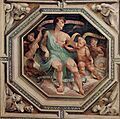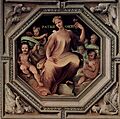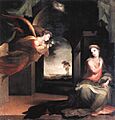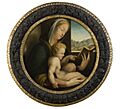Domenico Beccafumi facts for kids
Quick facts for kids
Domenico Beccafumi
|
|
|---|---|
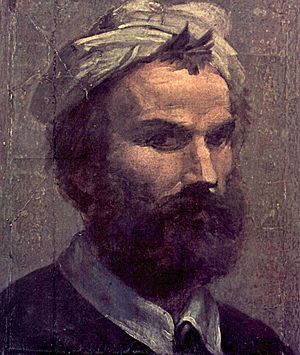
Self-portrait, around 1525–1530
|
|
| Born |
Domenico di Pace Beccafumi
1486 Montaperti, Italy
|
| Died | May 18, 1551 Siena, Italy
|
| Nationality | Italian |
| Known for | Painter |
| Movement | Mannerism |
Domenico di Pace Beccafumi (1486–May 18, 1551) was an Italian painter. He was active mostly in Siena during the Renaissance and Mannerism art periods. He is known as one of the last important artists from the Sienese school of painting.
Contents
About Domenico Beccafumi
Domenico was born in Montaperti, a town near Siena. His father, Giacomo di Pace, was a farmer. Lorenzo Beccafumi, who owned the land, noticed Domenico's talent for drawing. Lorenzo adopted him and helped him learn painting from a Sienese artist named Mechero.
In 1509, Domenico traveled to Rome. There, he learned from artists who were working in the Vatican. However, he soon returned to Siena. Unlike some other Sienese artists who adopted the Roman style, Beccafumi's art kept its unique Sienese look. In Siena, he painted religious scenes for churches. He also created mythological art for private homes. His style was only slightly influenced by the Mannerist trends popular in Florence. His drawings often had a misty, uneven quality with strong colors. This made his work different from the famous Roman masters.
Siena Cathedral Floor
Besides painting, Beccafumi also worked on the famous floor of the Siena Cathedral. He directed this project from 1517 to 1544. The cathedral floor is made of many pieces of marble. It shows large designs created by engraving black outlines into white marble. The borders have colorful patterns.
Beccafumi made clever improvements to how the floor was created. He designed scenes from stories like Ahab and Elijah, Melchisedec, Abraham, and Moses. He also built a grand arch and a huge mechanical horse. These were used for the parade when Emperor Charles V visited Siena.
Beccafumi's Unique Art Style
Compared to the balanced art style of Florence, Sienese painting often looked more emotional and less orderly. In Beccafumi's paintings, buildings sometimes appear cut off. The way things look far away can seem a bit strange. His colors might also seem unusual together.
For example, in his painting Nativity (at the Church of San Martino), angels float in a circle like part of a building. Figures enter from the dark shadows of a broken arch. In his Annunciation, the Virgin Mary and the Angel Gabriel glow brightly. But the house around them is in shadows, making it hard to tell if it's day or night.
In Christ in Limbo (Pinacoteca Nazionale, Siena), Jesus stands in a twisting pose. He enters a shadowy underworld filled with ruins and souls. Beccafumi's figures are often lively and unusual. While his religious scenes include all the expected parts, they feel like a play where the actors wear strange costumes and forget some of their lines.
In the Middle Ages, Siena was a big rival to Florence in art, money, and politics. But wars and natural disasters caused Siena to decline by the 1400s. Beccafumi is seen as one of the last artists from the Sienese tradition. He blended medieval beliefs with the new ideas of the Renaissance.

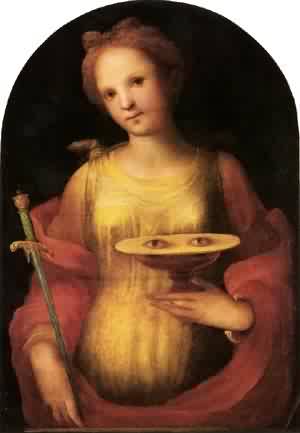
Some of His Works
- The Miraculous Communion of St Catherine of Siena (1513) – J. Paul Getty Museum, Los Angeles
- Saint Catherine of Siena Receiving the Stigmata (1513) – J. Paul Getty Museum, Los Angeles
- Trinity Triptych (1513) – Oil on wood, 152 x 228 cm, Pinacoteca Nazionale, Siena
- Holy Family with the Infant Saint John the Baptist (around 1514–1515) – Uffizi, Florence
- Marriage of St Catherine (1514–1515) – Pinacoteca Nazionale, Siena
- Bellanti Madonna (around 1515) – Pinacoteca Nazionale, Siena
- St. Paul (1515) – Oil on wood, 190 x 150 cm, Museo dell'Opera Metropolitana, Siena
- Marcia (1519), National Gallery, London
- Stigmatization of St. Catherine of Siena (1515) – Oil on wood, 208 x 156 cm, Pinacoteca Nazionale, Siena
- The Betrothal of the Virgin (1518) – Fresco, 295 x 304 cm, Oratory of San Bernardino, Siena
- Tanaquil (1519) – Oil on wood, 92 x 53 cm, National Gallery, London
- Self Portrait (1520)
- The Story of Papirius (1520–1530) – National Gallery, London
- St. Lucy (1521) – Oil on wood, Pinacoteca Nazionale, Siena
- Mystical Marriage of St. Catherine (1521) – Hermitage, St. Petersburg
- Holy Family with the Infant Saint John the Baptist (around 1521–1522) – Galleria Palatina, Florence
- Frescoes – Palazzo Bindi-Segardi, Siena
- Frescoes of scenes from Roman history – Palazzo Pubblico, Siena (1529–1535)
- The Holy Family with Young Saint John (1523–1524) – Oil on panel, diameter 86 cm, Museo Thyssen-Bornemisza, Madrid
- Fall of the Rebel Angels (around 1524) – Pinacoteca Nazionale, Siena
- Fall of the Rebel Angels (around 1528) – Oil on wood, 347 x 225 cm, San Niccolò al Carmine, Siena
- Mystic Marriage of Saint Catherine (1528) – Palazzo Chigi-Saracini, Siena
- Vision of St. Catherine of Sienna (1528) – Philbrook Museum of Art, Tulsa
- The Baptism of Christ (1528) – Philbrook Museum of Art, Tulsa
- The Nativity – Allentown Art Museum, Allentown
- Venus and Cupid with Vulcan (1528) – New Orleans Museum of Art, New Orleans
- Holy Family with St. John (around 1530) – Oil on panel, diameter 84 cm, Uffizi, Florence
- Holy Family with Saint Anne – Private collection
- Flight of Clelia and the Roman Virgins – Uffizi, Florence
- Punishment of Dathan – Pisa Cathedral
- Drawing for Christ in Limbo (Stolen)
- Christ in Limbo (1535) – Pinacoteca Nazionale, Siena
- Moses and the Golden Calf (1536–1537) – Oil on wood, 197 x 139 cm, Pisa Cathedral
- Saint Bernard of Siena Preaching (1537) – Musée du Louvre, Paris
- Saint Anthony and the Miracle of the Mule (1537) – Musée du Louvre, Paris
- Saint Francis receives the stigmata (1537) – Musée du Louvre, Paris
- Coronation of the Virgin (1539) – Pinacoteca Nazionale, Siena
- Birth of the Virgin (1543) – Oil on wood, 233 x 145 cm, Accademia, Siena
- Sarteano Annunciation (around 1546) – Oil on canvas, San Martino in Foro, Sarteano
- Coronation of the Virgin (1540s) – Santo Spirito, Siena
- Madonna with infant and St. John (1540) – Oil on panel, 90 x 65 cm, Galleria Nazionale d'Arte Antica, Rome
- Holy Family with Angels – National Gallery of Art, Washington, DC
- Holy Family and St. John – Alte Pinakothek, Munich
- Statues of Angels (1548–1550) – Presbytery of Siena Cathedral
- Judith with the Head of Holofernes – The Wallace Collection, London.
- Drawing of Abraham
- St. Peter – Woodcut, Cleveland Museum of Art
- Angels drawing (1524–25) – San Francisco
Gallery
-
The Annunciation (1545)
-
Saint Catherine receives the stigmata (1545)
See also
 In Spanish: Beccafumi para niños
In Spanish: Beccafumi para niños




